Every Saturday morning, my grandmother’s kitchen was filled with the warm, inviting aroma of freshly baked scones. These moments inspired my love for creating Scones (Any Flavor), a versatile and timeless recipe perfect for breakfast, brunch, or tea.
Imagine taking warm, flaky scones (Any Flavor) out of the oven. It’s a cozy and thrilling experience. This recipe is perfect for both beginners and experienced cooks. It will become your favorite weekend activity.
Scones are great for breakfast, brunch, or tea. They’re easy to make with just a few ingredients. You’ll soon be making treats that taste like they came from a bakery.
Key Takeaways
- Learn to make delicious homemade Scones (Any Flavor) with minimal ingredients
- Discover multiple flavor variations to suit any taste preference
- Master the art of creating perfectly textured scones every time
- Understand the secrets to achieving flaky, tender scone texture
- Explore both sweet and savory scone recipes
Understanding the Magic of Homemade Scones (Any Flavor)
Baking scones is an art that turns simple ingredients into delightful treats. Your journey into homemade scones starts with knowing their unique traits. These traits make them different from other pastries.
Getting the perfect scone texture needs careful technique and detail. The ideal scone has:
- A golden-brown exterior
- A tender, flaky interior
- Light and crumbly consistency
- Subtle buttery flavor
Scone vs Pastry: Understanding the Difference
When comparing scones to other pastries, several key distinctions emerge in the traditional scone recipe:
| Characteristic | Scones | Other Pastries |
|---|---|---|
| Mixing Method | Minimal handling | More extensive mixing |
| Fat Content | Less buttery | Higher fat percentage |
| Texture | Crumbly and light | Smoother and denser |
Traditional vs Modern Scones (Any Flavor) Making
Traditional scone making focuses on simplicity. Modern techniques add new flavors and creative touches. The key is balancing respect for tradition with culinary creativity.
“A great scone tells a story of technique, tradition, and personal touch.”
Remember, mastering the perfect scone texture takes practice. Don’t be discouraged if your first attempts aren’t perfect – each batch brings you closer to scone excellence!
Essential Ingredients for Basic Scone Recipe
Making delicious homemade scones begins with knowing the key ingredients. These ingredients turn simple items into a tasty treat. Your basic scone recipe needs a mix of high-quality parts for the perfect texture.
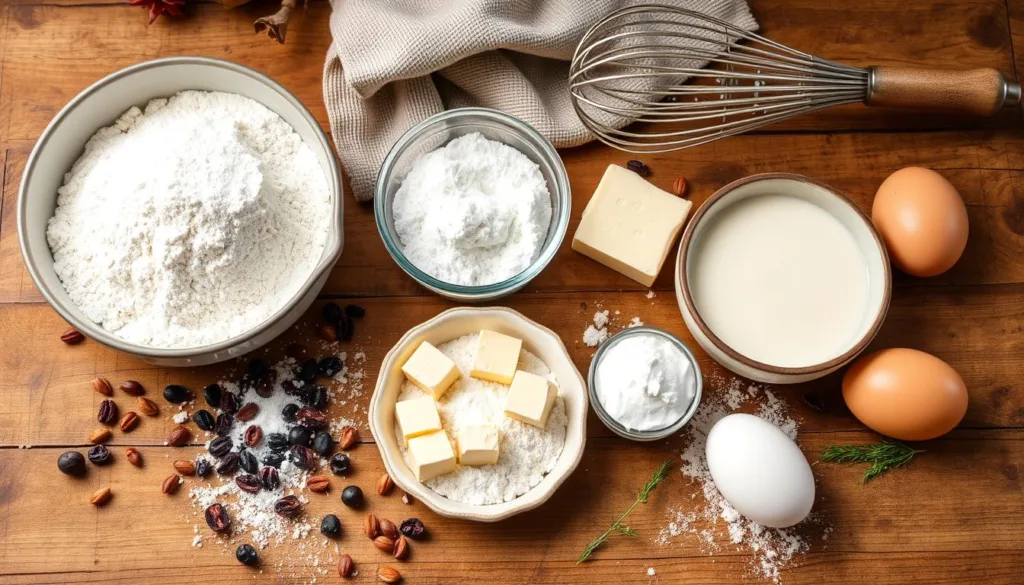
- Flour: All-purpose flour (2 cups or 250g) is the base of your scones
- Granulated sugar (¼ cup or 50g) adds a touch of sweetness
- Baking powder helps your scones rise
- Kosher salt boosts the flavor
- Cold unsalted butter (½ cup or 113g) makes them flaky
- Heavy cream (½ cup or 120ml) adds richness and binds the dough
“The magic of scones lies in the quality of ingredients and the precision of preparation.”
The quality of your ingredients greatly affects the outcome. Using high-quality European butter adds richness. Keeping all ingredients cold is key for flaky layers. Bakers suggest freezing butter for 15 minutes before mixing it into the dough.
Choosing the right ingredients is crucial. The right mix creates a professional-quality pastry in just 30 minutes.
Pro Tip for Mix-Ins
Customize your scones with mix-ins like:
- Fresh berries (3/4 to 1 cup)
- Chocolate chips
- Dried fruits
- Nuts
Knowing these essential ingredients helps you make bakery-quality treats at home!
Kitchen Tools and Equipment Needed
Making perfect scones needs the right tools. Whether you’re new or experienced, the right equipment makes a big difference.
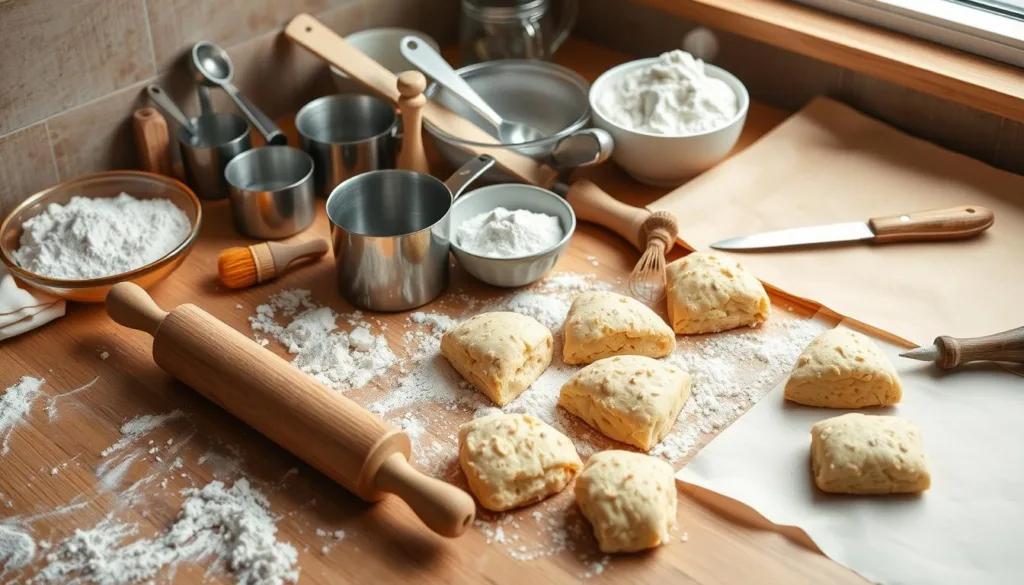
To make delicious scones, you need essential kitchen tools. These tools help you get bakery-quality results at home.
Must-Have Baking Tools for Scone Preparation
- Large Mixing Bowl: For combining dry and wet ingredients
- Pastry Blender: Critical for cutting cold butter into flour mixture
- Measuring cups and spoons
- Baking sheet with parchment paper
- Sharp knife for cutting dough
- Wire whisk
- Liquid measuring cup
Optional Equipment for Advanced Baking
For better scone-making, consider these tools:
- Stand mixer with paddle attachment
- Silicone baking mats
- Specialized scone pan for uniform shapes
- Digital kitchen scale for precise measurements
“The right tools transform good baking into great baking.” – Professional Baker’s Wisdom
Choose a heavy-duty baking sheet for even heat. A good pastry blender cuts butter into small pieces without warming the dough.
Pro tip: Keep your baking tools clean and well-maintained for consistent results.
Step-by-Step Mixing Technique
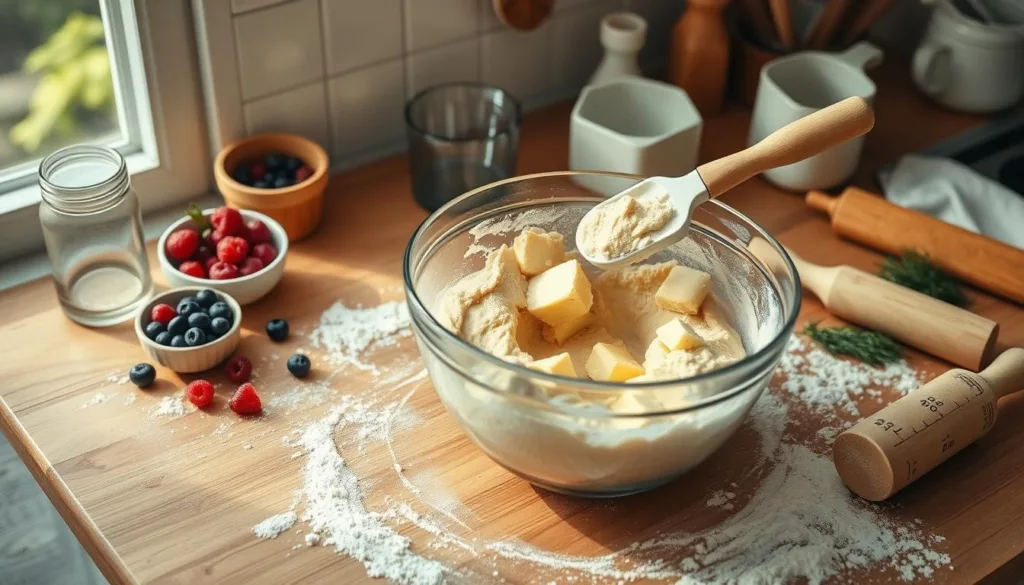
Learning how to mix scones is key to making them just like a bakery. It’s all about making scone dough with care and precision.
Cutting in butter is the most important step. It makes your scones flaky and tender. Cold butter is essential – it creates pockets that turn into layers when baked.
“The magic of scones is in the subtle art of mixing – less is always more.”
Here’s a simple way to mix scone dough:
- Gather all ingredients at cool room temperature
- Sift dry ingredients thoroughly
- Cut cold butter into small cubes
- Use a pastry cutter or your fingertips to incorporate butter
- Mix until butter resembles coarse cornmeal
- Add liquid ingredients gently
- Fold until just combined – do not overmix
Pro tip: For extra-flaky scones, freeze your butter and flour mixture for 5-10 minutes before adding liquid. This keeps the butter cold, which is crucial for texture.
The perfect scone dough should look a bit shaggy and feel cool. Don’t overwork it – gentle mixing is the secret to success!
Mastering the Perfect Scone Texture
Creating the perfect scone is all about precision and understanding key baking techniques. The texture of your scones depends on several crucial factors. These factors can turn your baking from ordinary to extraordinary.
The Importance of Cold Butter in Scones
Cold butter is the secret to achieving flaky layers in your scones. When you use cold butter, you create pockets of fat. These pockets melt during baking, giving you a light, tender crumb.
- Cut butter into small cubes before mixing
- Keep butter refrigerated until just before use
- Use a pastry cutter or your fingertips to incorporate butter
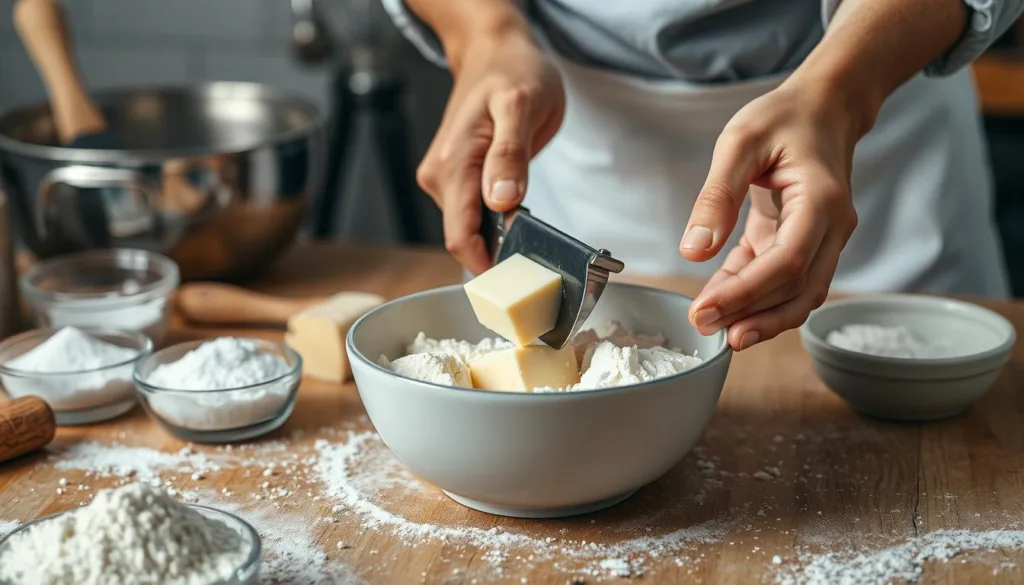
Achieving the Right Scone Dough Consistency
The consistency of your scone dough is key to a perfect pastry. Your dough should be crumbly yet hold together just enough. Overworking the dough can make your scones tough and dense.
“The less you handle the dough, the more tender your scones will be.” – Professional Baker’s Tip
For the best scone texture, mix minimally and handle gently. Aim for a dough that looks shaggy but can be pressed together. Chill the shaped scones for 15-20 minutes before baking. This helps keep their structure and creates beautiful layers.
| Dough Characteristic | Ideal Result |
|---|---|
| Mixing Time | Minimal (just until ingredients combine) |
| Dough Appearance | Crumbly but holds together |
| Chilling Time | 15-20 minutes before baking |
Remember, practice makes perfect when it comes to mastering scone texture. Each batch will help you understand the delicate balance of ingredients and technique.
Scones (Any Flavor) – Versatile Base Recipe
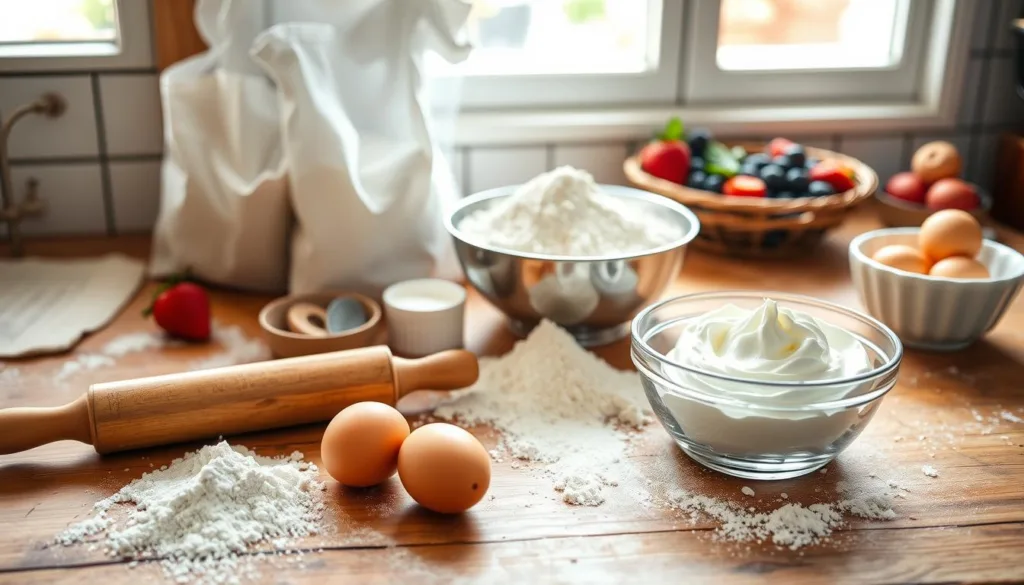
Making a versatile scone base opens up a world of possibilities. Your basic scone recipe is a starting point for many flavors. It can turn a simple pastry into a gourmet delight.
The secret to a great Scones (Any Flavor) base is in the ingredients. They give structure and flavor. Here’s what you need:
- All-purpose flour: The main ingredient for structure
- Sugar: Adds a touch of sweetness
- Baking powder: Makes the scones light and fluffy
- Salt: Boosts the flavor
- Cold butter: Creates a flaky texture
- Egg: Holds everything together
- Milk or cream: Adds moisture
With just a few ingredient changes, your Scones (Any Flavor) base can become anything. Want something sweet like chocolate-cherry or savory like bacon-cheddar? The basic recipe is your starting point.
| Flavor Category | Potential Add-ins | Recommended Quantity |
|---|---|---|
| Sweet Variations | Chocolate chips, dried fruits, nuts | 1/2 to 3/4 cup |
| Savory Variations | Cheese, herbs, bacon bits | 1/2 to 3/4 cup |
| Citrus Variations | Lemon zest, orange zest | 1-2 tablespoons |
Pro tip: Always keep your ingredients cold and handle the dough minimally to ensure the most tender, flaky scones possible.
Sweet Flavor Variations and Add-ins
Take your scone baking to the next level with creative sweet flavors. These flavors can turn a simple scone recipe into a special treat. Exploring different sweet scone flavors makes baking a fun adventure.
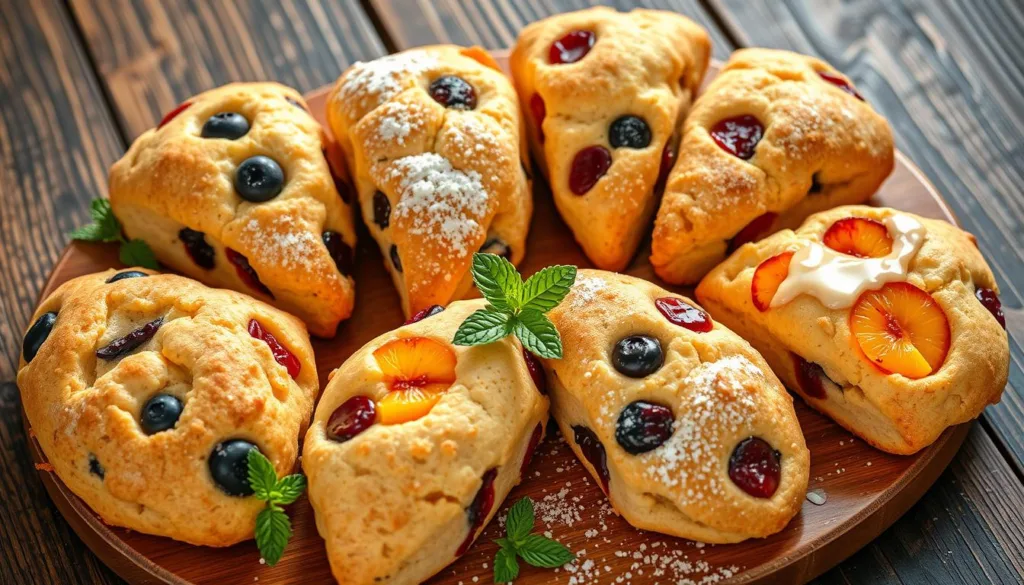
Fruit and Chocolate Combinations
Fruit scones add natural sweetness and vibrant flavors. Here are some tasty combinations:
- Chocolate-Cherry: Dried cherries with semisweet chocolate chunks
- Blueberry-Lemon: Fresh blueberries with zesty lemon zest
- Cranberry-Orange: Tart cranberries with bright orange peel
Chocolate Scones with Unique Twists
Chocolate scones can get even better with creative mix-ins. Try these rich variations:
- Dark Chocolate-Hazelnut
- White Chocolate-Macadamia Nut
- Chocolate Chip-Espresso
Nuts and Spice Options
Add crunchy nuts and warm spices for deeper flavors:
- Pecan-Brown Sugar
- Pistachio-Cardamom
- Almond-Cinnamon
Glazing and Topping Ideas
| Glaze Type | Flavor Profile |
|---|---|
| Vanilla Bean | Classic sweet finish |
| Maple Cream | Rich, autumnal taste |
| Citrus Drizzle | Bright, tangy accent |
Top your scones with:
- Coarse sugar crystals
- Sliced almonds
- Citrus zest
Pro tip: Experiment with different flavor combinations to discover your signature scone recipe!
Savory Scone Variations
Discover the world of savory Scones (Any Flavor) and spice up your baking. Cheese and herb scones are a tasty change from sweet treats. They add rich flavors to your meals.
Make your savory scones stand out with the right ingredients and methods. Here are some delicious variations to boost your baking:
- Bacon and Cheddar Herb Scones
- Ham and Swiss Cheese Scones
- Rosemary and Asiago Scones
- Pimiento Cheese Scones
“Savory scones are the perfect canvas for culinary creativity!” – Professional Baker
When making savory scones, keep these tips in mind:
| Ingredient Category | Suggested Options | Flavor Impact |
|---|---|---|
| Cheese | Cheddar, Parmesan, Gouda | Rich, tangy base |
| Herbs | Chives, Rosemary, Thyme | Fresh, aromatic notes |
| Protein | Bacon, Ham, Crumbled Sausage | Depth and texture |
Tip for cheese scones: Grate cheese cold and mix it with dry ingredients for best flavor. The secret to great savory scones is a light texture and bold flavors.
Try new mixes like pear and blue cheese or spinach and feta for amazing herb scones. The trick is to balance flavors and keep butter cold for a tender crumb.
Professional Baking Tips and Tricks
Mastering scone baking needs precision and detail. Whether you’re new or experienced, these tips will improve your skills. They’ll take your pastry-making to the next level.
Temperature Control for Perfect Scones
Getting the right scone temperature is key for flaky pastries. Professional bakers stress the importance of oven temperature. Here are some temperature tips:
- Preheat your oven to 375°F (190°C) for the best results
- Use an oven thermometer for accurate temperature
- Keep butter cold until just before mixing
Visual Cues for Scone Doneness
Knowing when scones are done takes practice and observation. Look for these signs:
- Golden-brown edges
- Firm, set tops
- Light, slightly crisp exterior
“The secret to perfect scones is in the details of temperature and timing.” – Professional Baker
| Scone Size | Baking Time | Expected Appearance |
|---|---|---|
| Large scones | 15-18 minutes | Golden edges, set center |
| Mini scones | 12-15 minutes | Light brown, crisp exterior |
Pro tip: Space scones 2-3 inches apart for even cooking. Cold butter and minimal handling are crucial for flaky texture.
Storage and Reheating Guidelines
Learning how to store and reheat scones is key to enjoying them for days. Keeping them fresh is all about the right storage.
- Store freshly baked Scones (Any Flavor) in an airtight container at room temperature
- Consume room-temperature scones within 1-2 days for optimal freshness
- Separate layers with parchment paper to prevent sticking
Freezing is the best way to keep scones for longer:
- Wrap individual scones in plastic wrap
- Place wrapped scones in a freezer-safe container
- Freeze for up to one month
Reheating scones needs gentle care to keep them soft. Here are the best ways:
| Reheating Method | Temperature | Time |
|---|---|---|
| Conventional Oven | 350°F (175°C) | 5-8 minutes |
| Toaster Oven | Low heat | 2-3 minutes |
| Air Fryer | 325°F (160°C) | 3-5 minutes |
Pro tip: Always thaw frozen scones at room temperature for about an hour before reheating to ensure even warming.
Warning: Avoid microwaving scones, as this can make them tough and diminish their delightful texture.
Serving Suggestions and Pairings
Make your scone experience unforgettable with the right pairings. Whether you prefer sweet or savory scones, the right toppings can elevate them. This turns a simple treat into a gourmet delight.
Traditional Accompaniments
Classic scone toppings offer a mix of flavors that enhance the pastry’s texture. Here are some timeless options:
- Clotted cream – a quintessential British topping
- Fruit preserves like strawberry or raspberry jam
- Lemon curd for a tangy twist
- Honey-butter spread
Modern Serving Ideas
Scone pairings have grown beyond traditional tea-time treats. Try these modern ideas to refresh your scone experience:
- Create breakfast sandwiches with savory cheese scones
- Pair cheese scones with fresh garden salads
- Serve sweet scones alongside fruit compotes
“A perfectly served scone is an art form that marries flavor, texture, and presentation.”
For drinks, consider these options:
- Classic Earl Grey tea
- Freshly brewed espresso
- Sparkling wine for an elegant touch
- Mimosas for a celebratory brunch
Remember, creativity and personal taste are key to serving scones well. Feel free to try new combinations to find your favorite!
Conclusion
Baking homemade scones opens a world of creativity. You’ll discover endless flavors and techniques. This turns a simple pastry into a delightful treat.
The benefits of homemade scones go beyond taste. You can make scones as good as those from a bakery. Whether you like sweet blueberry or savory herb scones, your kitchen becomes a place for fun.
Your scone baking journey is about simplicity and flexibility. With basic ingredients and practice, you can make scones that wow everyone. Remember, measuring carefully, keeping ingredients cold, and handling dough gently are crucial for the perfect texture.
As you keep practicing, you’ll get better at making scones. Each batch is a chance to try new things and enjoy your baking. Embrace the journey, and your scone-making skills will become a treasured talent.
Explore More Delicious Recipes:
Looking for more comforting and flavorful dishes to add to your menu? Try our Cheesy Meatball Casserole, a hearty and cheesy delight perfect for family dinners, or dive into the bold flavors of our Ultimate Pastalaya Recipe, a fusion of pasta and jambalaya that’s sure to impress. These recipes are perfect for any occasion!
FAQ
What makes a scone different from other pastries?
Scones are made differently than other pastries. They have a lighter, flakier texture. This comes from a special mixing method that keeps the butter cold and the dough simple.
Can I make scones with dietary restrictions?
Yes, you can make scones for different diets. For gluten-free, use special flours. For dairy-free, use plant-based butter and milk. Vegan scones can be made with flax eggs and plant-based ingredients.
How do I prevent my scones from becoming tough?
To avoid tough scones, keep butter cold and mix dough little. Cut butter into flour until it’s small pea-sized. Mix wet ingredients gently until dough forms. Overmixing makes scones dense.
What are some popular scone flavor combinations?
Sweet scones include Chocolate-Cherry and Apricot-Ginger. Savory options are Bacon-Cheddar and Ham-Swiss. These flavors offer many choices for any taste.
How long can I store homemade scones?
Eat scones the same day for best taste. Store them in an airtight container for 1-2 days. Freeze for longer storage. Reheat in a low oven or toaster oven, not the microwave.
What is the best flour for making scones?
Use all-purpose flour for scones. It has the right protein for a tender crumb. Try pastry flour for a lighter texture or whole wheat for a nuttier taste.
Can I make scones without a pastry blender?
Yes, you can make scones without a pastry blender. Use knives, a fork, or a food processor. Keep butter cold for a flaky texture.
What are some serving suggestions for scones?
Serve warm scones with butter, jam, or lemon curd. Use them in breakfast sandwiches or with soups and salads. Enjoy sweet scones with tea or coffee. For a treat, pair them with sparkling wine or mimosas.

Scones (Any Flavor)
Ingredients
- 2 cups all-purpose flour 250g
- ¼ cup granulated sugar 50g
- 1 tablespoon baking powder
- ½ teaspoon kosher salt
- ½ cup cold unsalted butter 113g, cut into small cubes
- ½ cup heavy cream 120ml
Instructions
- Preheat your oven to 375°F (190°C) and line a baking sheet with parchment paper.
- In a large mixing bowl, sift together the flour, sugar, baking powder, and salt.
- Cut in the cold butter using a pastry blender until the mixture resembles coarse cornmeal.
- Pour in the heavy cream and gently fold until just combined; do not overmix.
- Turn the dough onto a floured surface and gently shape it into a disc about 1-inch thick.
- Cut into triangles or rounds and place on the prepared baking sheet.
- Chill the shaped scones for 15-20 minutes before baking.
- Bake for 15-18 minutes or until golden brown and firm on top.
- Let cool slightly and serve warm with clotted cream or jam.

